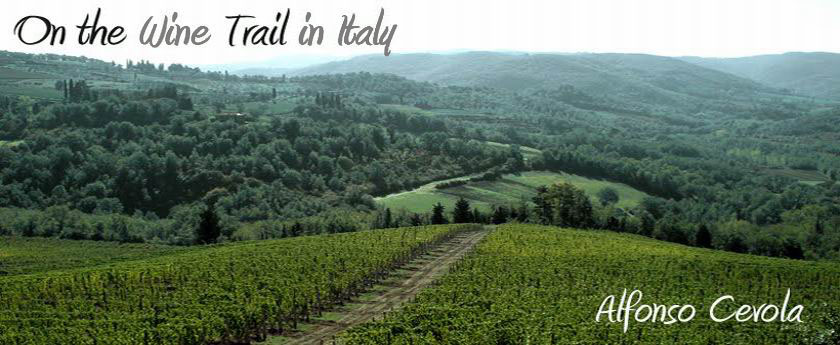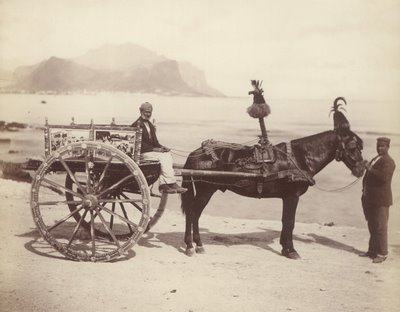Right now I am sitting in a room at midnight and it’s 85 degrees F. It’s the middle of June and we have at least 3 months of this inferno to go. We’re in a drought, the wind is blowing from the west, range fires crop up and clear cotton fields, threaten livestock. We’re living in a harsh environment and that’s before you take into account the social aspect that we’ve found ourselves in. What was it like?
 I can only imagine what they were thinking 100 years ago, when where they were, in Calabria, looked as inviting as that West Texas dust storm raging on the plains. Devastating earthquake, utter breakdown in civilization, a civilization that had been established in the 6th Century B.C. Desperation, hope,a clean slate, away, just far,far away.
I can only imagine what they were thinking 100 years ago, when where they were, in Calabria, looked as inviting as that West Texas dust storm raging on the plains. Devastating earthquake, utter breakdown in civilization, a civilization that had been established in the 6th Century B.C. Desperation, hope,a clean slate, away, just far,far away. The train took us from Brindisi to Cosenza and we followed Merlin back in time, the pine tree forest through the mountains over the hill. Back to grandmothers house. It was the harvest season, September, in a year that would be remembered, by some, as a better than average harvest. 1977.
The train took us from Brindisi to Cosenza and we followed Merlin back in time, the pine tree forest through the mountains over the hill. Back to grandmothers house. It was the harvest season, September, in a year that would be remembered, by some, as a better than average harvest. 1977.Cosenza was as it might have been 30 years before. Ten years later a taste of the outside would plant itself in that sleepy little southern town. For now, all we had was a name, Bucita. Somewhere in the hills we would find our cousins and uncles and aunts. And the legacy of their love of the land, and the grape.
 Walking into the village, an overwhelming balm infused the air. Ripe figs, roasting inside their leaves in stone ovens. Honey, bay leaf, chestnut-like complex aromas. Unforgettable.
Walking into the village, an overwhelming balm infused the air. Ripe figs, roasting inside their leaves in stone ovens. Honey, bay leaf, chestnut-like complex aromas. Unforgettable.An older man on a donkey approaches us. Yes he thinks he knows who we
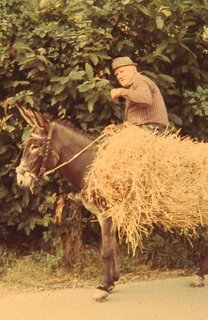 are looking for. This man, Giuseppe takes me to his house where his wife Teodalinda is standing on a stone floor. My grandfather put that floor in. In his wine cellar Giuseppe would later initiate me into a world where wine held secrets and mysteries inside bottles and barrels. He was a winemaker and the harvest was in full swing.
are looking for. This man, Giuseppe takes me to his house where his wife Teodalinda is standing on a stone floor. My grandfather put that floor in. In his wine cellar Giuseppe would later initiate me into a world where wine held secrets and mysteries inside bottles and barrels. He was a winemaker and the harvest was in full swing.On the same train, another cousin, Luigi, traveled home. We followed Giuseppe and our interpreter, Antonio (Tony), to a small ancient home. On the table, with a demijohn of red wine and some fresh cookies, and the figs, were pictures of my parents on their wedding day. Connection.
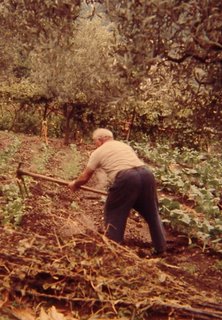 We were just in time, the family needed hands in the fields, a storm front was threatening the harvest. Grape harvest reports supplanted the soccer games on the local TV, people were more interested in the price of Greco or Gaglioppo than Rossi or Zaccarelli. Time was contracting.
We were just in time, the family needed hands in the fields, a storm front was threatening the harvest. Grape harvest reports supplanted the soccer games on the local TV, people were more interested in the price of Greco or Gaglioppo than Rossi or Zaccarelli. Time was contracting.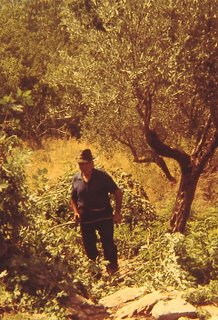 The elements here dominate the environment, the sun, the rain, lightning, thunder. Earth, alive and moving. Here comes the sun. Luigi, finding some of his vines have been washed away, clears out a creek bed for water flow. After two nights of Olympian pyrotechnics, the people of the land were given back the hill. Like goats we swarmed the vineyards, competing with the bees for the nectar. His wine vats await the harvest.
The elements here dominate the environment, the sun, the rain, lightning, thunder. Earth, alive and moving. Here comes the sun. Luigi, finding some of his vines have been washed away, clears out a creek bed for water flow. After two nights of Olympian pyrotechnics, the people of the land were given back the hill. Like goats we swarmed the vineyards, competing with the bees for the nectar. His wine vats await the harvest. Another cousin, Giovanni, has been in his olive groves, they seem to have survived. Tonight his wife Elvira, will be making home made pasta, casalinga, and eggplant, melanzane I segreti della nonna.
Another cousin, Giovanni, has been in his olive groves, they seem to have survived. Tonight his wife Elvira, will be making home made pasta, casalinga, and eggplant, melanzane I segreti della nonna.Sitting in Giovanni’s home with Luigi and Tony,
 Elvira and Francesco the weaver, drinking Giovanni’s excellent wine. Below us in the basement is Giuseppe’s wine room, the hum of thousands of crushed grapes fermenting. Teodalinda’s wine flushed face as she posed for a photograph with her husband and a glass of their wine, the ever ringing bells reminding
Elvira and Francesco the weaver, drinking Giovanni’s excellent wine. Below us in the basement is Giuseppe’s wine room, the hum of thousands of crushed grapes fermenting. Teodalinda’s wine flushed face as she posed for a photograph with her husband and a glass of their wine, the ever ringing bells reminding 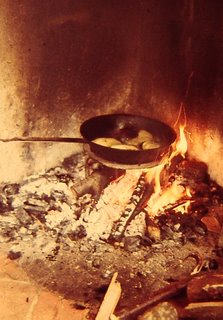 one of the presence of time even in a place like Bucita. They are all gone now.
one of the presence of time even in a place like Bucita. They are all gone now.What remains is the offspring of those days, a life devoted to the legacy of the winemakers met in those early autumn days in southern Italy, in Old Calabria. Since then I have studied wine in books and passed exams certifying me in some realm of wine specialization. But never were those books,
 even those vaulted chateaus in France, ever as influential and meaningful as spending long evenings in a room lit by a bare bulb with the elders, drinking their wine and talking into the early hours of the morning.
even those vaulted chateaus in France, ever as influential and meaningful as spending long evenings in a room lit by a bare bulb with the elders, drinking their wine and talking into the early hours of the morning. What was it like? In Bucita we found our people close to their land, eating the food they
 grew, drinking the wine they made, fresh air, clean, pure, sweet water. Their legacy of local. Individuals, charitable people, people whose lives hadn’t been too easy, but souls still able to give and keep on giving. My mother’s people, for so long a mystery to us, to find them was an amazing gift. To be with them and in their daily life was an experience I will never forget.
grew, drinking the wine they made, fresh air, clean, pure, sweet water. Their legacy of local. Individuals, charitable people, people whose lives hadn’t been too easy, but souls still able to give and keep on giving. My mother’s people, for so long a mystery to us, to find them was an amazing gift. To be with them and in their daily life was an experience I will never forget.My destiny was being weaved in that place.
